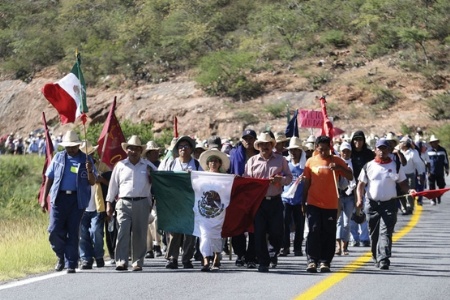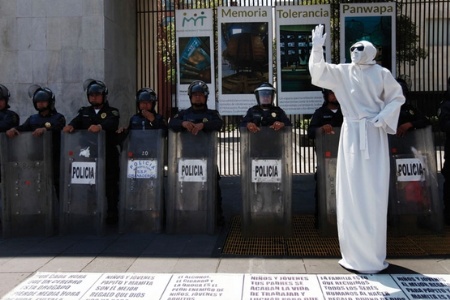Source: PA/Getty
Growing up in the southern Mexican town of Putla Villa de Guerrero, Lili Gracida Jiménez watched with dismay as teachers lined up students by intelligence, calling the worst-performing children names.
“My teachers were cruel,” says Gracida Jiménez, who went on to graduate from Benito Juárez Autonomous University of Oaxaca and now teaches Spanish at a private language school in the capital city of Oaxaca, which has the same name as the state. “If you weren’t thought to be intelligent, they called you a burro”, or donkey.
Two decades after the cruelty Gracida Jiménez experienced, teaching remains a concern in the southern state, which is one of the poorest in the country.
In 2006 Oaxaca drew worldwide attention for a seven-month popular uprising in which the teachers’ union played a key role. Protesters’ clashes with police led to multiple deaths and widespread international condemnation, by academics in particular, for alleged human rights abuses by security forces.
According to a World Bank report published in February, the poor quality of the state’s schools is one of the factors hindering Oaxaca’s higher education institutions.
The organisation’s study, Educación Superior y Desarrollo en Oaxaca (Higher Education and Development in Oaxaca), is part of a larger effort to help Oaxaca, which has a population of 3.8 million, battle its poverty, health and development problems, which are among Mexico’s worst.
Higher education is among the keys to solving those challenges, the report notes.
The state finds itself in a strange situation, says Miguel Székely, director of the Institute for Innovation in Education based in Monterrey, Mexico and author of the World Bank report.
Of the minuscule number of Oaxacans who gain a university degree, one out of five has been trained to teach at a primary school, Székely found, and many of those teachers have not been trained well.
Moreover, he argues, in a state where the primary school-age population is declining, there is a dearth of university graduates in disciplines that would help the economy.
“If this [the number of graduates going into teaching] was construction, electricity or software, it would make more sense,” Székely says. “There’s this element of imbalance in Oaxaca.”
The state would be better served encouraging young people to study disciplines such as energy technology, tourism and mining, he adds.

Union ‘paralysis’
Székely says Oaxaca faces some unique obstacles, chief among them the state’s teachers’ union, which he says frequently shuts down the capital city’s roads with demonstrations and controls most aspects of teaching in the state.
He contends that the state government - led by Gabino Cué Monteagudo of the social democratic Citizen’s Movement, whose 2010 election victory ended the 80-year reign of the Institutional Revolutionary Party - must wrest control from the union in order to direct more teachers into secondary schools and more tertiary students into fields other than teacher training.
The more teachers the state trains, the more power the union gains and the lower the chance the state will change the system, he contends. “The phenomenon of the teachers’ union in Oaxaca has been very powerful, mainly because they can paralyse the state. It’s a very peculiar thing that’s going on in Oaxaca.”
The government body in charge of Oaxacan higher education, the State Commission for Higher Education Planning, declined to discuss most of the World Bank’s findings.
But in an email interview, the commission’s technical secretary, Marcial Ocampo Ojeda, says the body is aware of many of the state’s problems and intends to “redouble efforts…to cope with and reverse negative indices”.
However, Ocampo Ojeda disputes Székely’s conclusion that Oaxaca produces too many teachers, saying that it is an “economic reality” that the state needs more teachers.
But the state government’s own general development plan for 2011-16, published in 2011, notes the failure of the state’s 100-plus higher education institutions, including public and private universities and vocational schools, to connect with industries to better train the workforce in disciplines that would help Oaxaca.
“It should be noted that there is no job placement or training of professionals with business skills,” the document states.
The World Bank, presently aiding Oaxaca to improve water quality and maternal health, has proposed a number of solutions to the state’s higher education woes.
Oaxaca should do more to prevent dropouts in schools, particularly secondary schools, Székely recommends in the report, and universities need to modernise their curricula to train students for 21st-century careers.
The bank also recommends that the state offer significantly more scholarships, including funds to support low-income students from primary school through to university.
Oaxaca’s general development plan notes that a shortfall of 20,000 scholarships was partly responsible for the state’s inability to attract university students.
And, the World Bank report concludes, Oaxaca should generate more corporate participation in education by steering students towards programmes of study that will lead companies to invest materials and equipment in Oaxaca.
Improving Oaxaca’s economy “needs to be an important part of educational policy in the state”, Székely says.
However, some obstacles will be more easily overcome than others.
Among the state’s greatest hurdles to increasing participation and achievement in education are the hundreds of far-flung, isolated towns to which teachers often must travel for more than an hour every day, and the language barriers that hamper teachers’ communication with students from the state’s large indigenous community.

Too many teachers, too few graduates
Oaxaca is rich in natural resources, but many of its ecosystems are under threat from haphazard development. Safeguarding those resources requires people educated to university level in the sciences, says Rodolfo Dirzo, director of Stanford University’s Center for Latin American Studies.
“I truly believe education is the key to solving those problems,” says Dirzo, an environmental scientist who has worked extensively in Oaxaca. “Unfortunately, Oaxaca has not paid attention.”
Dirzo says he noticed a lack of aspiration to attend universities among Oaxacan students. According to World Bank figures, only 20 per cent of students who enter Oaxaca’s primary schools go on to higher education - less than half of Mexico’s national average of 43 per cent - and just 12 per cent complete a college or university degree.
“Students should be told often about the different fields that are available to study in universities,” Dirzo says. “It’s a crucial step that should be repeated time and again.”
Throughout the primary grades, school was not the place to find motivation, says Gracida Jiménez, who adds that her parents were mostly responsible for her decision to pursue a university degree. Other students were not as lucky, she adds.
“Parents don’t tell children about the importance of education,” she says. “Parents have this responsibility to change things, and teachers could do more.”
But motivation is not the only essential asset some pupils lack, according Gracida Jiménez, who says many poorer children come to school without having eaten breakfast.
For the few students who do succeed, it is easy to understand why they would opt to become schoolteachers, a career that brings stable employment, good benefits and ample vacation time, she adds. Gracida Jiménez notes that friends with university degrees in other fields have been unable to find permanent employment.
“They do other things, like work in stores, cook and drive taxis,” says Gracida Jiménez, who hopes to continue teaching languages to adults. “It’s difficult to find work in Oaxaca.”
The World Bank, drawing on 2010 data, said that 5.7 per cent of Oaxacans who completed higher education were unemployed, more than twice the national average.
Stability is among the main reasons that Selene Mendoza, a native of Oaxaca state, says she plans to teach in a primary school, although she has yet to be assigned to a school.
“In other areas, you’re not sure you’ll get paid every 15 days,” she says. “Being a teacher is a stable job for many years.”
But too many teachers are looking for an easy job, Dirzo claims. He contends that an oversupply of teachers who have little interest in helping students is hurting the state.
Oaxacan students consistently score poorly on standardised tests, according to national figures.
“There is a need for a better balance between quality and quantity,” Dirzo says.
“That’s the situation I perceive being the problem with education in the state. They’re sacrificing quality for quantity.
“I think the time is right to reverse that.”
Register to continue
Why register?
- Registration is free and only takes a moment
- Once registered, you can read 3 articles a month
- Sign up for our newsletter
Subscribe
Or subscribe for unlimited access to:
- Unlimited access to news, views, insights & reviews
- Digital editions
- Digital access to THE’s university and college rankings analysis
Already registered or a current subscriber? Login
